History - The first world war in Europe
VerifiedAdded on 2022/08/28
|14
|3739
|20
AI Summary
Contribute Materials
Your contribution can guide someone’s learning journey. Share your
documents today.
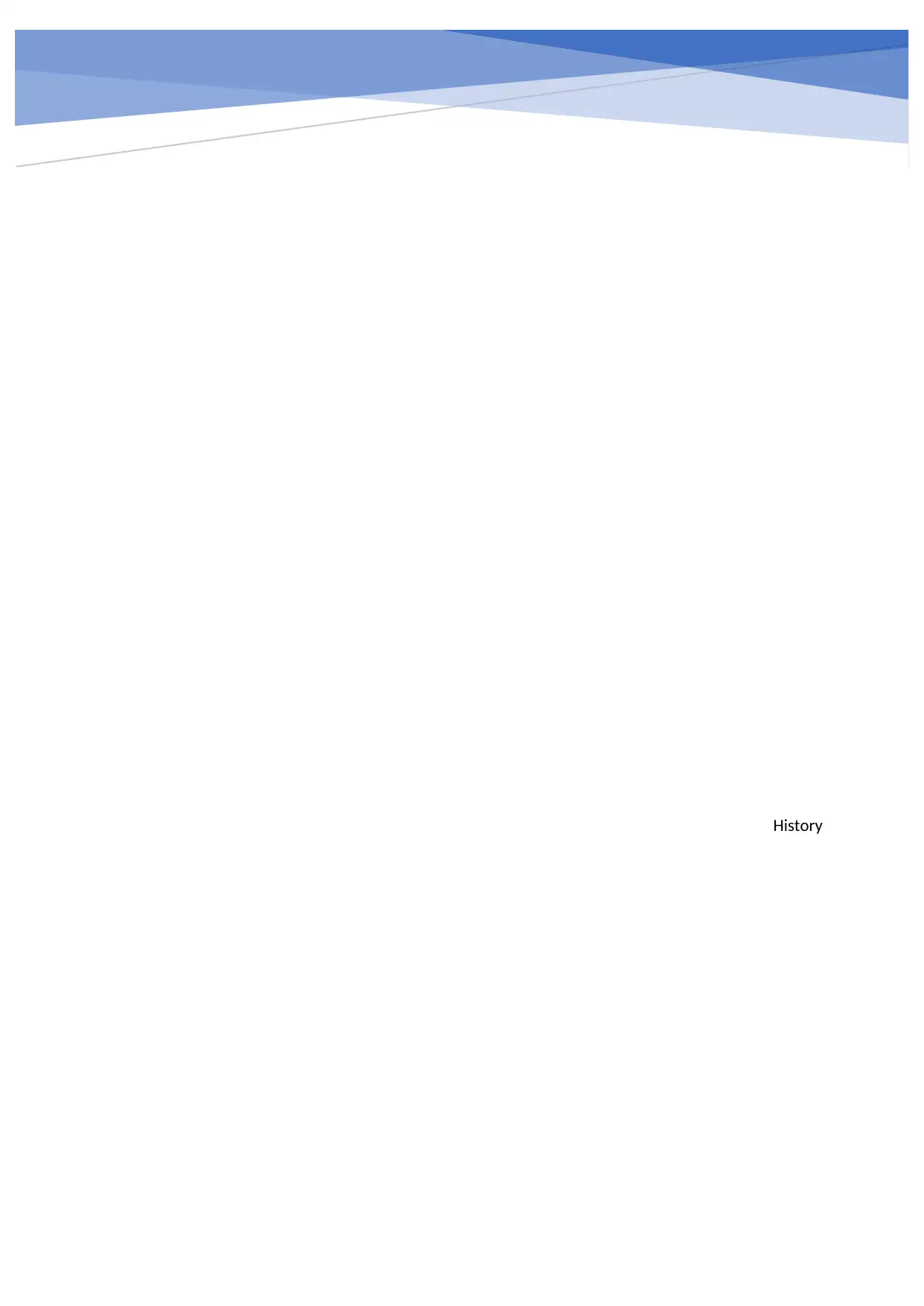
History
Secure Best Marks with AI Grader
Need help grading? Try our AI Grader for instant feedback on your assignments.
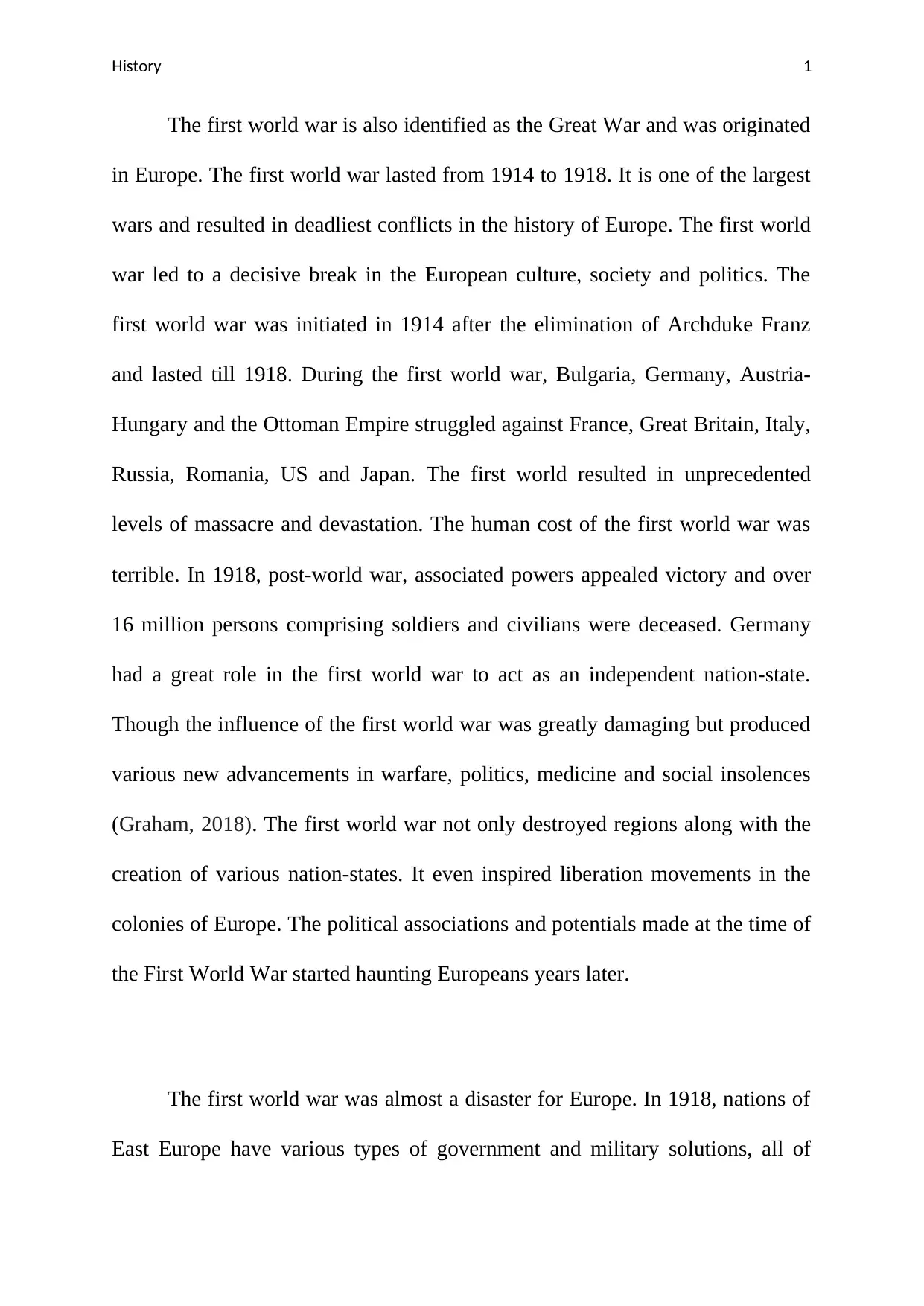
History 1
The first world war is also identified as the Great War and was originated
in Europe. The first world war lasted from 1914 to 1918. It is one of the largest
wars and resulted in deadliest conflicts in the history of Europe. The first world
war led to a decisive break in the European culture, society and politics. The
first world war was initiated in 1914 after the elimination of Archduke Franz
and lasted till 1918. During the first world war, Bulgaria, Germany, Austria-
Hungary and the Ottoman Empire struggled against France, Great Britain, Italy,
Russia, Romania, US and Japan. The first world resulted in unprecedented
levels of massacre and devastation. The human cost of the first world war was
terrible. In 1918, post-world war, associated powers appealed victory and over
16 million persons comprising soldiers and civilians were deceased. Germany
had a great role in the first world war to act as an independent nation-state.
Though the influence of the first world war was greatly damaging but produced
various new advancements in warfare, politics, medicine and social insolences
(Graham, 2018). The first world war not only destroyed regions along with the
creation of various nation-states. It even inspired liberation movements in the
colonies of Europe. The political associations and potentials made at the time of
the First World War started haunting Europeans years later.
The first world war was almost a disaster for Europe. In 1918, nations of
East Europe have various types of government and military solutions, all of
The first world war is also identified as the Great War and was originated
in Europe. The first world war lasted from 1914 to 1918. It is one of the largest
wars and resulted in deadliest conflicts in the history of Europe. The first world
war led to a decisive break in the European culture, society and politics. The
first world war was initiated in 1914 after the elimination of Archduke Franz
and lasted till 1918. During the first world war, Bulgaria, Germany, Austria-
Hungary and the Ottoman Empire struggled against France, Great Britain, Italy,
Russia, Romania, US and Japan. The first world resulted in unprecedented
levels of massacre and devastation. The human cost of the first world war was
terrible. In 1918, post-world war, associated powers appealed victory and over
16 million persons comprising soldiers and civilians were deceased. Germany
had a great role in the first world war to act as an independent nation-state.
Though the influence of the first world war was greatly damaging but produced
various new advancements in warfare, politics, medicine and social insolences
(Graham, 2018). The first world war not only destroyed regions along with the
creation of various nation-states. It even inspired liberation movements in the
colonies of Europe. The political associations and potentials made at the time of
the First World War started haunting Europeans years later.
The first world war was almost a disaster for Europe. In 1918, nations of
East Europe have various types of government and military solutions, all of
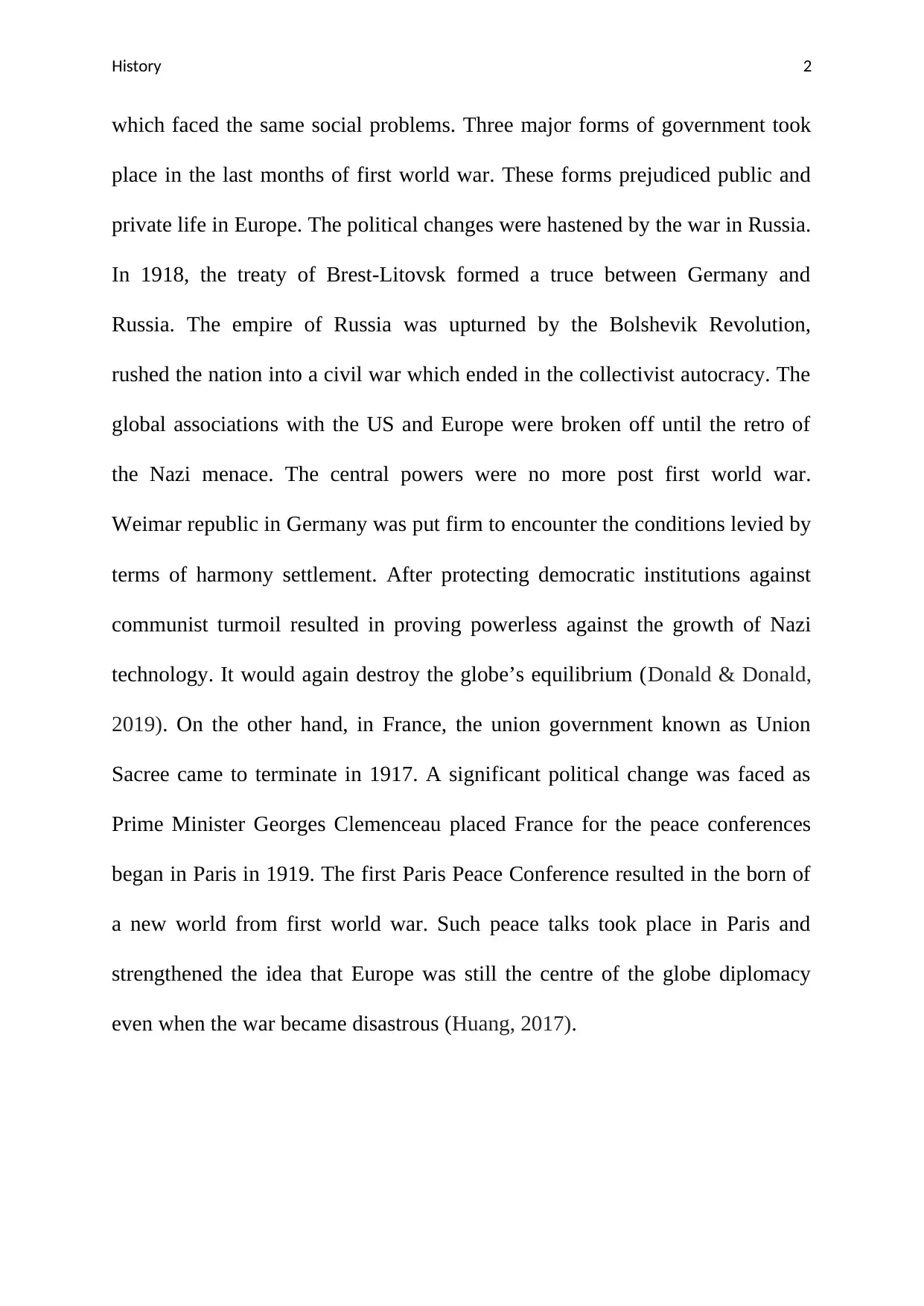
History 2
which faced the same social problems. Three major forms of government took
place in the last months of first world war. These forms prejudiced public and
private life in Europe. The political changes were hastened by the war in Russia.
In 1918, the treaty of Brest-Litovsk formed a truce between Germany and
Russia. The empire of Russia was upturned by the Bolshevik Revolution,
rushed the nation into a civil war which ended in the collectivist autocracy. The
global associations with the US and Europe were broken off until the retro of
the Nazi menace. The central powers were no more post first world war.
Weimar republic in Germany was put firm to encounter the conditions levied by
terms of harmony settlement. After protecting democratic institutions against
communist turmoil resulted in proving powerless against the growth of Nazi
technology. It would again destroy the globe’s equilibrium (Donald & Donald,
2019). On the other hand, in France, the union government known as Union
Sacree came to terminate in 1917. A significant political change was faced as
Prime Minister Georges Clemenceau placed France for the peace conferences
began in Paris in 1919. The first Paris Peace Conference resulted in the born of
a new world from first world war. Such peace talks took place in Paris and
strengthened the idea that Europe was still the centre of the globe diplomacy
even when the war became disastrous (Huang, 2017).
which faced the same social problems. Three major forms of government took
place in the last months of first world war. These forms prejudiced public and
private life in Europe. The political changes were hastened by the war in Russia.
In 1918, the treaty of Brest-Litovsk formed a truce between Germany and
Russia. The empire of Russia was upturned by the Bolshevik Revolution,
rushed the nation into a civil war which ended in the collectivist autocracy. The
global associations with the US and Europe were broken off until the retro of
the Nazi menace. The central powers were no more post first world war.
Weimar republic in Germany was put firm to encounter the conditions levied by
terms of harmony settlement. After protecting democratic institutions against
communist turmoil resulted in proving powerless against the growth of Nazi
technology. It would again destroy the globe’s equilibrium (Donald & Donald,
2019). On the other hand, in France, the union government known as Union
Sacree came to terminate in 1917. A significant political change was faced as
Prime Minister Georges Clemenceau placed France for the peace conferences
began in Paris in 1919. The first Paris Peace Conference resulted in the born of
a new world from first world war. Such peace talks took place in Paris and
strengthened the idea that Europe was still the centre of the globe diplomacy
even when the war became disastrous (Huang, 2017).
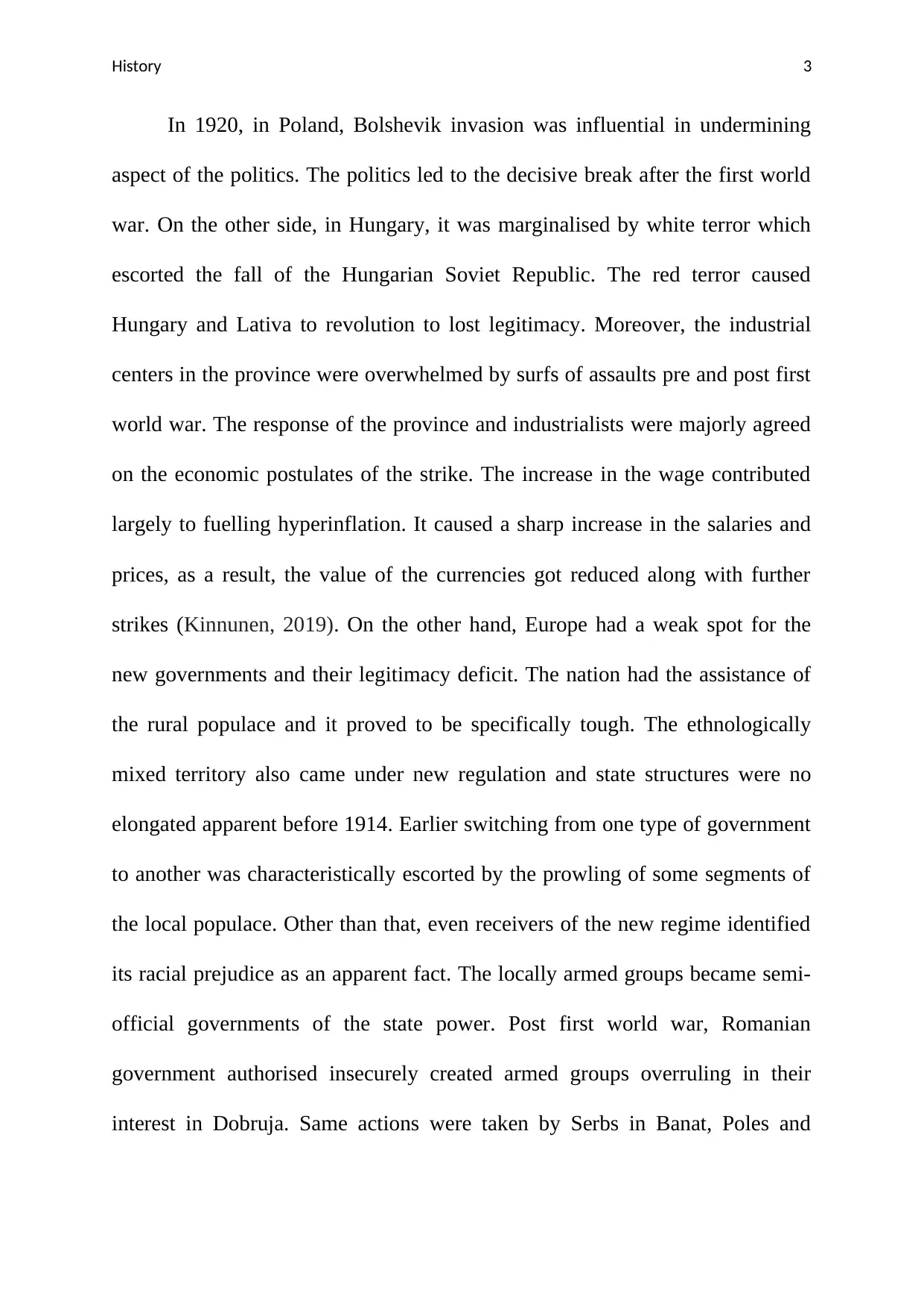
History 3
In 1920, in Poland, Bolshevik invasion was influential in undermining
aspect of the politics. The politics led to the decisive break after the first world
war. On the other side, in Hungary, it was marginalised by white terror which
escorted the fall of the Hungarian Soviet Republic. The red terror caused
Hungary and Lativa to revolution to lost legitimacy. Moreover, the industrial
centers in the province were overwhelmed by surfs of assaults pre and post first
world war. The response of the province and industrialists were majorly agreed
on the economic postulates of the strike. The increase in the wage contributed
largely to fuelling hyperinflation. It caused a sharp increase in the salaries and
prices, as a result, the value of the currencies got reduced along with further
strikes (Kinnunen, 2019). On the other hand, Europe had a weak spot for the
new governments and their legitimacy deficit. The nation had the assistance of
the rural populace and it proved to be specifically tough. The ethnologically
mixed territory also came under new regulation and state structures were no
elongated apparent before 1914. Earlier switching from one type of government
to another was characteristically escorted by the prowling of some segments of
the local populace. Other than that, even receivers of the new regime identified
its racial prejudice as an apparent fact. The locally armed groups became semi-
official governments of the state power. Post first world war, Romanian
government authorised insecurely created armed groups overruling in their
interest in Dobruja. Same actions were taken by Serbs in Banat, Poles and
In 1920, in Poland, Bolshevik invasion was influential in undermining
aspect of the politics. The politics led to the decisive break after the first world
war. On the other side, in Hungary, it was marginalised by white terror which
escorted the fall of the Hungarian Soviet Republic. The red terror caused
Hungary and Lativa to revolution to lost legitimacy. Moreover, the industrial
centers in the province were overwhelmed by surfs of assaults pre and post first
world war. The response of the province and industrialists were majorly agreed
on the economic postulates of the strike. The increase in the wage contributed
largely to fuelling hyperinflation. It caused a sharp increase in the salaries and
prices, as a result, the value of the currencies got reduced along with further
strikes (Kinnunen, 2019). On the other hand, Europe had a weak spot for the
new governments and their legitimacy deficit. The nation had the assistance of
the rural populace and it proved to be specifically tough. The ethnologically
mixed territory also came under new regulation and state structures were no
elongated apparent before 1914. Earlier switching from one type of government
to another was characteristically escorted by the prowling of some segments of
the local populace. Other than that, even receivers of the new regime identified
its racial prejudice as an apparent fact. The locally armed groups became semi-
official governments of the state power. Post first world war, Romanian
government authorised insecurely created armed groups overruling in their
interest in Dobruja. Same actions were taken by Serbs in Banat, Poles and
Secure Best Marks with AI Grader
Need help grading? Try our AI Grader for instant feedback on your assignments.
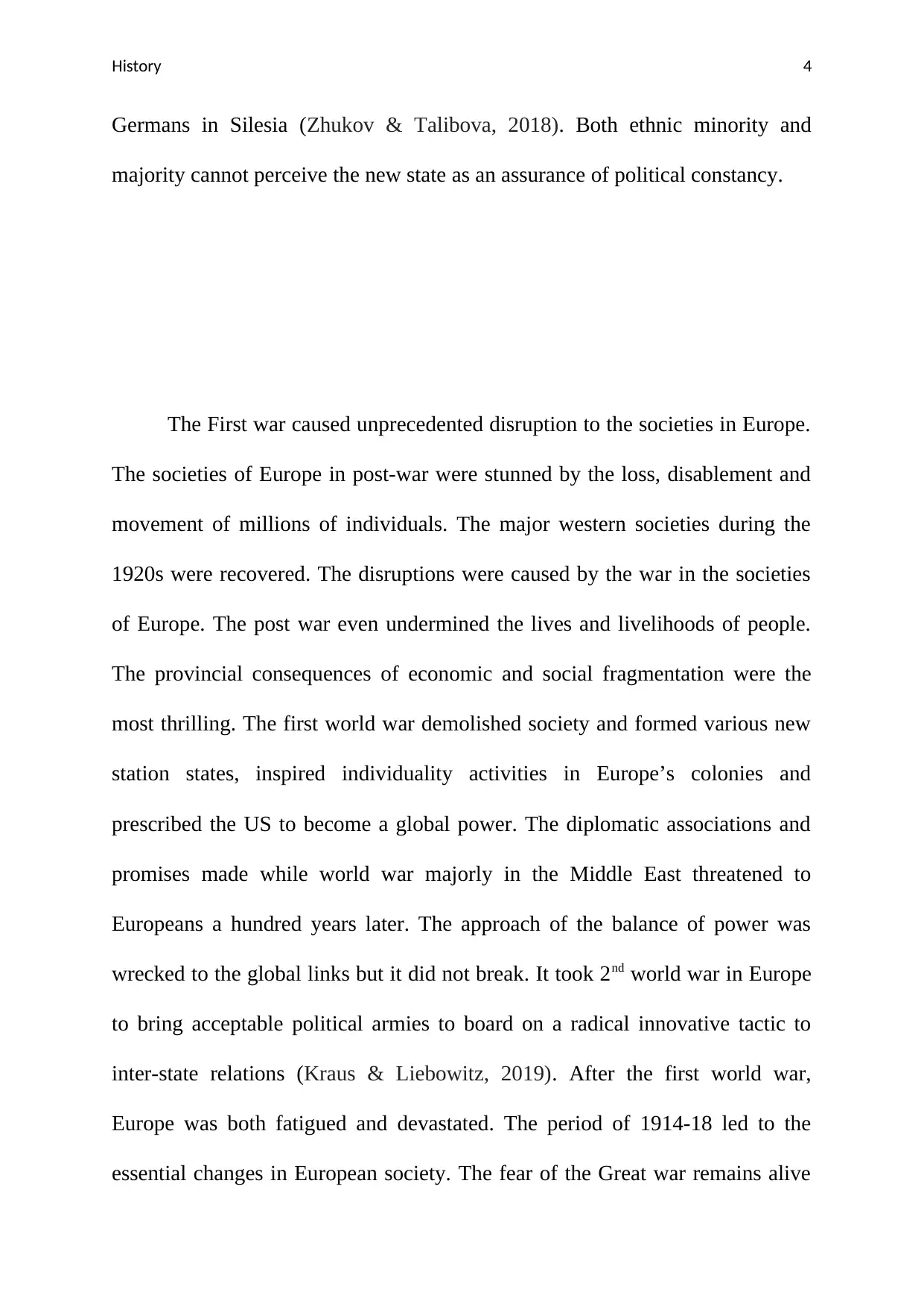
History 4
Germans in Silesia (Zhukov & Talibova, 2018). Both ethnic minority and
majority cannot perceive the new state as an assurance of political constancy.
The First war caused unprecedented disruption to the societies in Europe.
The societies of Europe in post-war were stunned by the loss, disablement and
movement of millions of individuals. The major western societies during the
1920s were recovered. The disruptions were caused by the war in the societies
of Europe. The post war even undermined the lives and livelihoods of people.
The provincial consequences of economic and social fragmentation were the
most thrilling. The first world war demolished society and formed various new
station states, inspired individuality activities in Europe’s colonies and
prescribed the US to become a global power. The diplomatic associations and
promises made while world war majorly in the Middle East threatened to
Europeans a hundred years later. The approach of the balance of power was
wrecked to the global links but it did not break. It took 2nd world war in Europe
to bring acceptable political armies to board on a radical innovative tactic to
inter-state relations (Kraus & Liebowitz, 2019). After the first world war,
Europe was both fatigued and devastated. The period of 1914-18 led to the
essential changes in European society. The fear of the Great war remains alive
Germans in Silesia (Zhukov & Talibova, 2018). Both ethnic minority and
majority cannot perceive the new state as an assurance of political constancy.
The First war caused unprecedented disruption to the societies in Europe.
The societies of Europe in post-war were stunned by the loss, disablement and
movement of millions of individuals. The major western societies during the
1920s were recovered. The disruptions were caused by the war in the societies
of Europe. The post war even undermined the lives and livelihoods of people.
The provincial consequences of economic and social fragmentation were the
most thrilling. The first world war demolished society and formed various new
station states, inspired individuality activities in Europe’s colonies and
prescribed the US to become a global power. The diplomatic associations and
promises made while world war majorly in the Middle East threatened to
Europeans a hundred years later. The approach of the balance of power was
wrecked to the global links but it did not break. It took 2nd world war in Europe
to bring acceptable political armies to board on a radical innovative tactic to
inter-state relations (Kraus & Liebowitz, 2019). After the first world war,
Europe was both fatigued and devastated. The period of 1914-18 led to the
essential changes in European society. The fear of the Great war remains alive
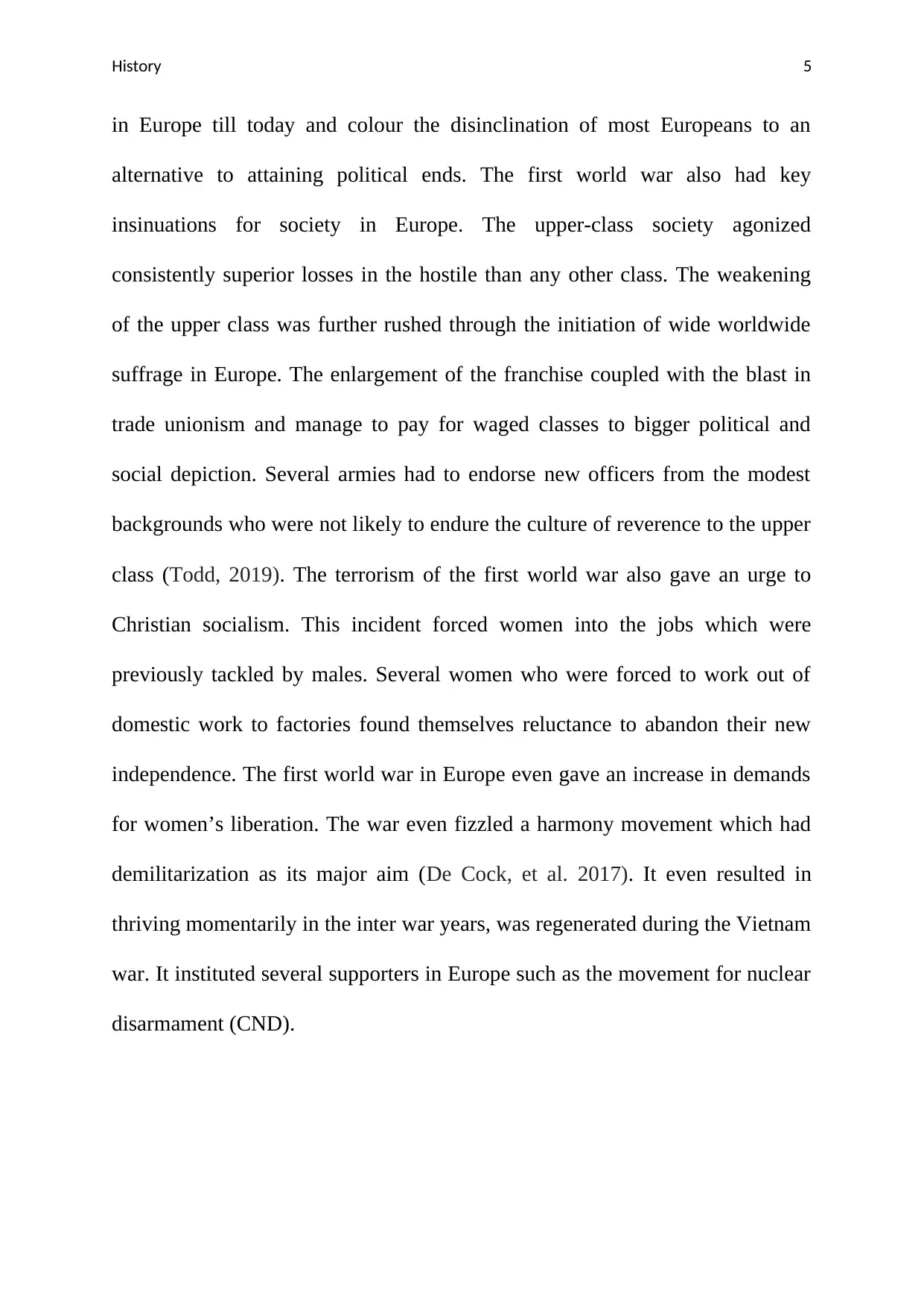
History 5
in Europe till today and colour the disinclination of most Europeans to an
alternative to attaining political ends. The first world war also had key
insinuations for society in Europe. The upper-class society agonized
consistently superior losses in the hostile than any other class. The weakening
of the upper class was further rushed through the initiation of wide worldwide
suffrage in Europe. The enlargement of the franchise coupled with the blast in
trade unionism and manage to pay for waged classes to bigger political and
social depiction. Several armies had to endorse new officers from the modest
backgrounds who were not likely to endure the culture of reverence to the upper
class (Todd, 2019). The terrorism of the first world war also gave an urge to
Christian socialism. This incident forced women into the jobs which were
previously tackled by males. Several women who were forced to work out of
domestic work to factories found themselves reluctance to abandon their new
independence. The first world war in Europe even gave an increase in demands
for women’s liberation. The war even fizzled a harmony movement which had
demilitarization as its major aim (De Cock, et al. 2017). It even resulted in
thriving momentarily in the inter war years, was regenerated during the Vietnam
war. It instituted several supporters in Europe such as the movement for nuclear
disarmament (CND).
in Europe till today and colour the disinclination of most Europeans to an
alternative to attaining political ends. The first world war also had key
insinuations for society in Europe. The upper-class society agonized
consistently superior losses in the hostile than any other class. The weakening
of the upper class was further rushed through the initiation of wide worldwide
suffrage in Europe. The enlargement of the franchise coupled with the blast in
trade unionism and manage to pay for waged classes to bigger political and
social depiction. Several armies had to endorse new officers from the modest
backgrounds who were not likely to endure the culture of reverence to the upper
class (Todd, 2019). The terrorism of the first world war also gave an urge to
Christian socialism. This incident forced women into the jobs which were
previously tackled by males. Several women who were forced to work out of
domestic work to factories found themselves reluctance to abandon their new
independence. The first world war in Europe even gave an increase in demands
for women’s liberation. The war even fizzled a harmony movement which had
demilitarization as its major aim (De Cock, et al. 2017). It even resulted in
thriving momentarily in the inter war years, was regenerated during the Vietnam
war. It instituted several supporters in Europe such as the movement for nuclear
disarmament (CND).
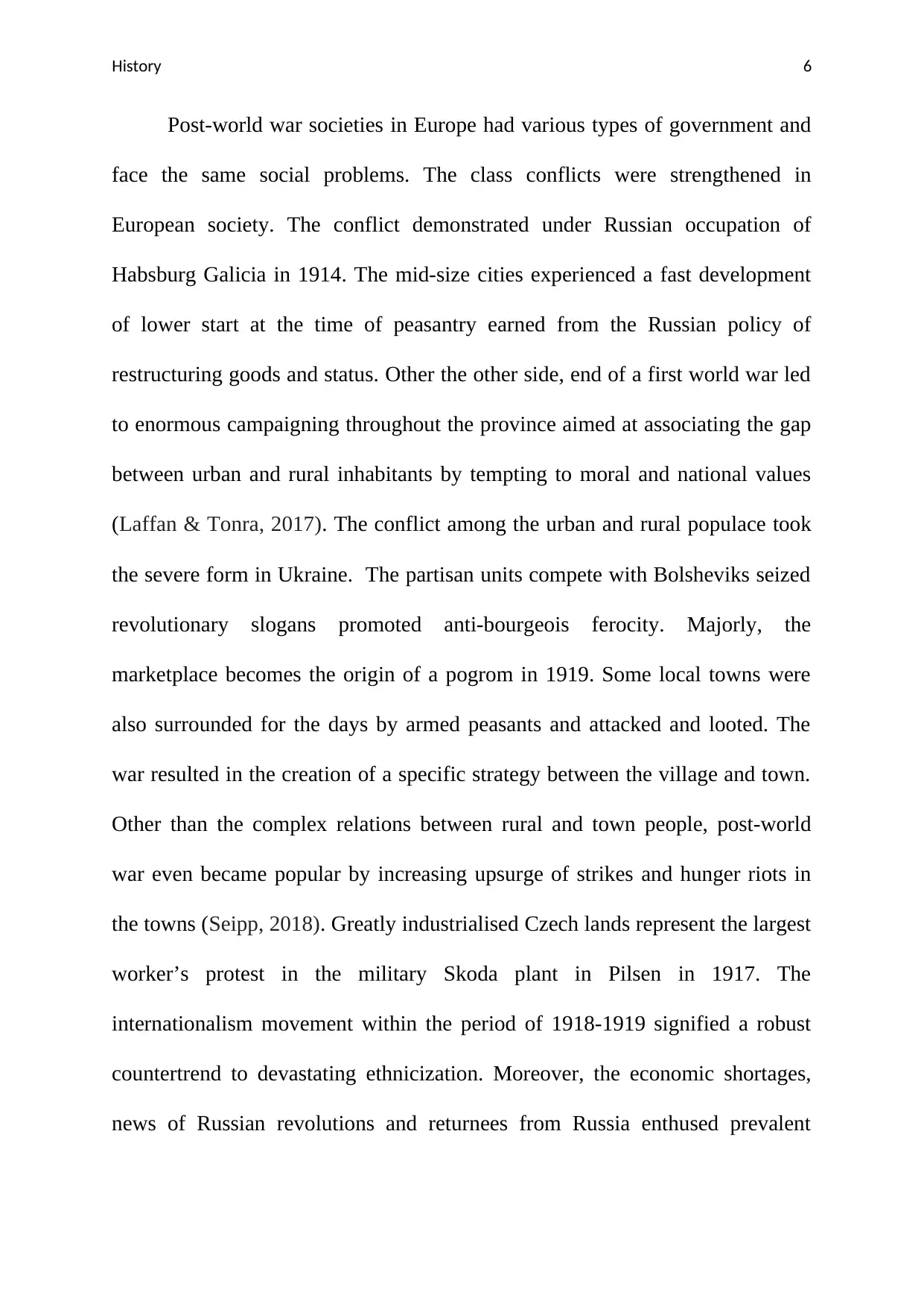
History 6
Post-world war societies in Europe had various types of government and
face the same social problems. The class conflicts were strengthened in
European society. The conflict demonstrated under Russian occupation of
Habsburg Galicia in 1914. The mid-size cities experienced a fast development
of lower start at the time of peasantry earned from the Russian policy of
restructuring goods and status. Other the other side, end of a first world war led
to enormous campaigning throughout the province aimed at associating the gap
between urban and rural inhabitants by tempting to moral and national values
(Laffan & Tonra, 2017). The conflict among the urban and rural populace took
the severe form in Ukraine. The partisan units compete with Bolsheviks seized
revolutionary slogans promoted anti-bourgeois ferocity. Majorly, the
marketplace becomes the origin of a pogrom in 1919. Some local towns were
also surrounded for the days by armed peasants and attacked and looted. The
war resulted in the creation of a specific strategy between the village and town.
Other than the complex relations between rural and town people, post-world
war even became popular by increasing upsurge of strikes and hunger riots in
the towns (Seipp, 2018). Greatly industrialised Czech lands represent the largest
worker’s protest in the military Skoda plant in Pilsen in 1917. The
internationalism movement within the period of 1918-1919 signified a robust
countertrend to devastating ethnicization. Moreover, the economic shortages,
news of Russian revolutions and returnees from Russia enthused prevalent
Post-world war societies in Europe had various types of government and
face the same social problems. The class conflicts were strengthened in
European society. The conflict demonstrated under Russian occupation of
Habsburg Galicia in 1914. The mid-size cities experienced a fast development
of lower start at the time of peasantry earned from the Russian policy of
restructuring goods and status. Other the other side, end of a first world war led
to enormous campaigning throughout the province aimed at associating the gap
between urban and rural inhabitants by tempting to moral and national values
(Laffan & Tonra, 2017). The conflict among the urban and rural populace took
the severe form in Ukraine. The partisan units compete with Bolsheviks seized
revolutionary slogans promoted anti-bourgeois ferocity. Majorly, the
marketplace becomes the origin of a pogrom in 1919. Some local towns were
also surrounded for the days by armed peasants and attacked and looted. The
war resulted in the creation of a specific strategy between the village and town.
Other than the complex relations between rural and town people, post-world
war even became popular by increasing upsurge of strikes and hunger riots in
the towns (Seipp, 2018). Greatly industrialised Czech lands represent the largest
worker’s protest in the military Skoda plant in Pilsen in 1917. The
internationalism movement within the period of 1918-1919 signified a robust
countertrend to devastating ethnicization. Moreover, the economic shortages,
news of Russian revolutions and returnees from Russia enthused prevalent
Paraphrase This Document
Need a fresh take? Get an instant paraphrase of this document with our AI Paraphraser
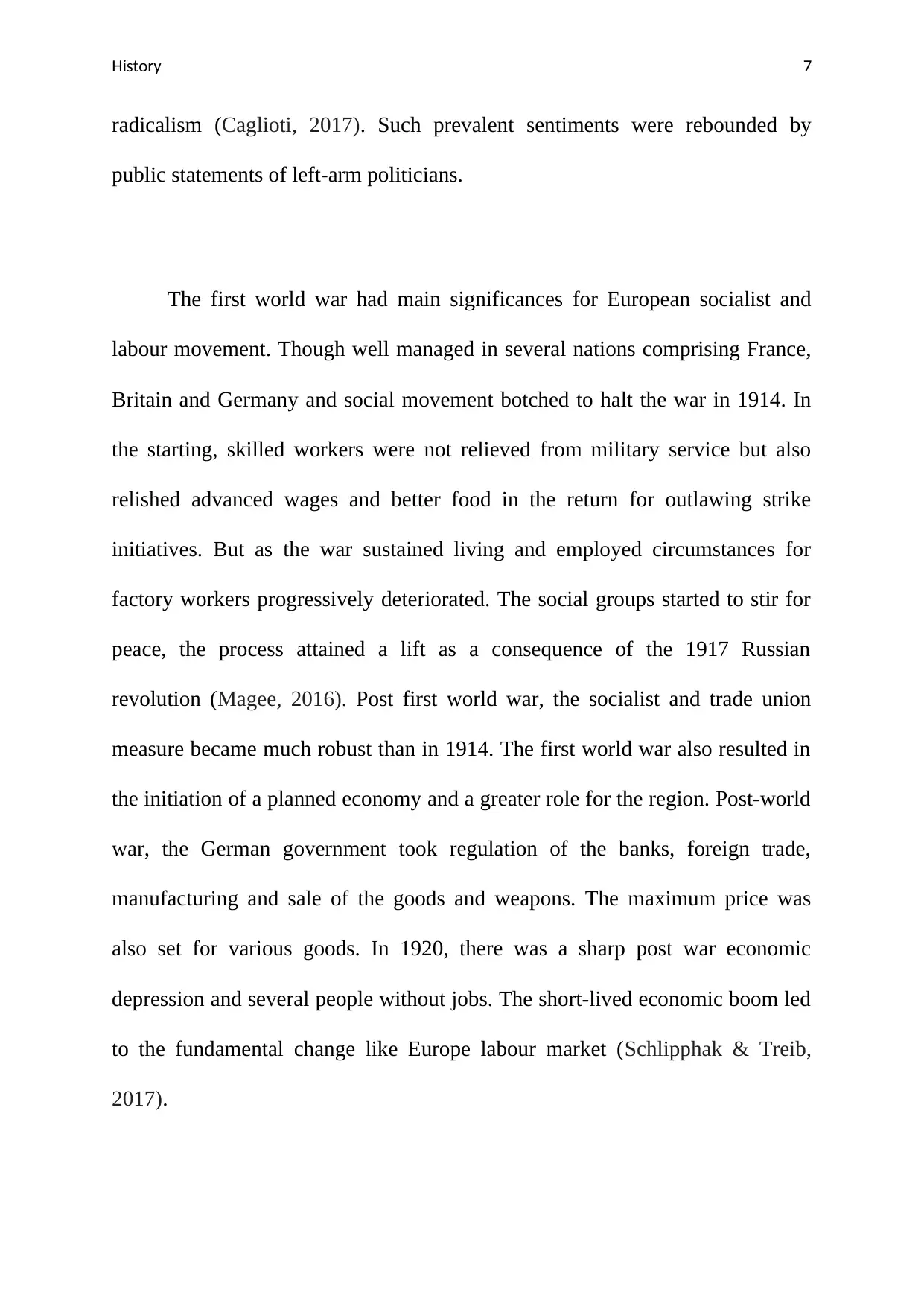
History 7
radicalism (Caglioti, 2017). Such prevalent sentiments were rebounded by
public statements of left-arm politicians.
The first world war had main significances for European socialist and
labour movement. Though well managed in several nations comprising France,
Britain and Germany and social movement botched to halt the war in 1914. In
the starting, skilled workers were not relieved from military service but also
relished advanced wages and better food in the return for outlawing strike
initiatives. But as the war sustained living and employed circumstances for
factory workers progressively deteriorated. The social groups started to stir for
peace, the process attained a lift as a consequence of the 1917 Russian
revolution (Magee, 2016). Post first world war, the socialist and trade union
measure became much robust than in 1914. The first world war also resulted in
the initiation of a planned economy and a greater role for the region. Post-world
war, the German government took regulation of the banks, foreign trade,
manufacturing and sale of the goods and weapons. The maximum price was
also set for various goods. In 1920, there was a sharp post war economic
depression and several people without jobs. The short-lived economic boom led
to the fundamental change like Europe labour market (Schlipphak & Treib,
2017).
radicalism (Caglioti, 2017). Such prevalent sentiments were rebounded by
public statements of left-arm politicians.
The first world war had main significances for European socialist and
labour movement. Though well managed in several nations comprising France,
Britain and Germany and social movement botched to halt the war in 1914. In
the starting, skilled workers were not relieved from military service but also
relished advanced wages and better food in the return for outlawing strike
initiatives. But as the war sustained living and employed circumstances for
factory workers progressively deteriorated. The social groups started to stir for
peace, the process attained a lift as a consequence of the 1917 Russian
revolution (Magee, 2016). Post first world war, the socialist and trade union
measure became much robust than in 1914. The first world war also resulted in
the initiation of a planned economy and a greater role for the region. Post-world
war, the German government took regulation of the banks, foreign trade,
manufacturing and sale of the goods and weapons. The maximum price was
also set for various goods. In 1920, there was a sharp post war economic
depression and several people without jobs. The short-lived economic boom led
to the fundamental change like Europe labour market (Schlipphak & Treib,
2017).
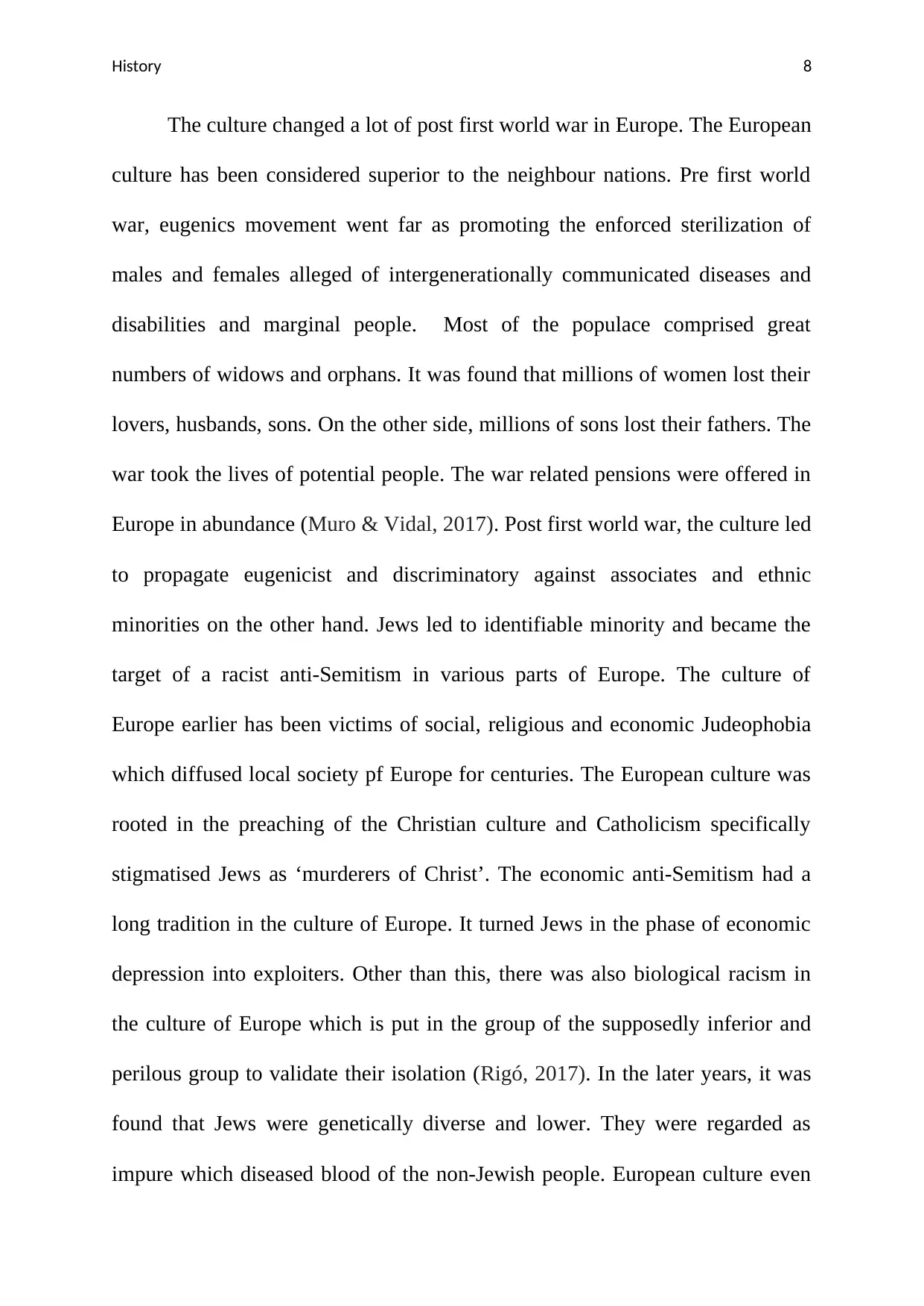
History 8
The culture changed a lot of post first world war in Europe. The European
culture has been considered superior to the neighbour nations. Pre first world
war, eugenics movement went far as promoting the enforced sterilization of
males and females alleged of intergenerationally communicated diseases and
disabilities and marginal people. Most of the populace comprised great
numbers of widows and orphans. It was found that millions of women lost their
lovers, husbands, sons. On the other side, millions of sons lost their fathers. The
war took the lives of potential people. The war related pensions were offered in
Europe in abundance (Muro & Vidal, 2017). Post first world war, the culture led
to propagate eugenicist and discriminatory against associates and ethnic
minorities on the other hand. Jews led to identifiable minority and became the
target of a racist anti-Semitism in various parts of Europe. The culture of
Europe earlier has been victims of social, religious and economic Judeophobia
which diffused local society pf Europe for centuries. The European culture was
rooted in the preaching of the Christian culture and Catholicism specifically
stigmatised Jews as ‘murderers of Christ’. The economic anti-Semitism had a
long tradition in the culture of Europe. It turned Jews in the phase of economic
depression into exploiters. Other than this, there was also biological racism in
the culture of Europe which is put in the group of the supposedly inferior and
perilous group to validate their isolation (Rigó, 2017). In the later years, it was
found that Jews were genetically diverse and lower. They were regarded as
impure which diseased blood of the non-Jewish people. European culture even
The culture changed a lot of post first world war in Europe. The European
culture has been considered superior to the neighbour nations. Pre first world
war, eugenics movement went far as promoting the enforced sterilization of
males and females alleged of intergenerationally communicated diseases and
disabilities and marginal people. Most of the populace comprised great
numbers of widows and orphans. It was found that millions of women lost their
lovers, husbands, sons. On the other side, millions of sons lost their fathers. The
war took the lives of potential people. The war related pensions were offered in
Europe in abundance (Muro & Vidal, 2017). Post first world war, the culture led
to propagate eugenicist and discriminatory against associates and ethnic
minorities on the other hand. Jews led to identifiable minority and became the
target of a racist anti-Semitism in various parts of Europe. The culture of
Europe earlier has been victims of social, religious and economic Judeophobia
which diffused local society pf Europe for centuries. The European culture was
rooted in the preaching of the Christian culture and Catholicism specifically
stigmatised Jews as ‘murderers of Christ’. The economic anti-Semitism had a
long tradition in the culture of Europe. It turned Jews in the phase of economic
depression into exploiters. Other than this, there was also biological racism in
the culture of Europe which is put in the group of the supposedly inferior and
perilous group to validate their isolation (Rigó, 2017). In the later years, it was
found that Jews were genetically diverse and lower. They were regarded as
impure which diseased blood of the non-Jewish people. European culture even
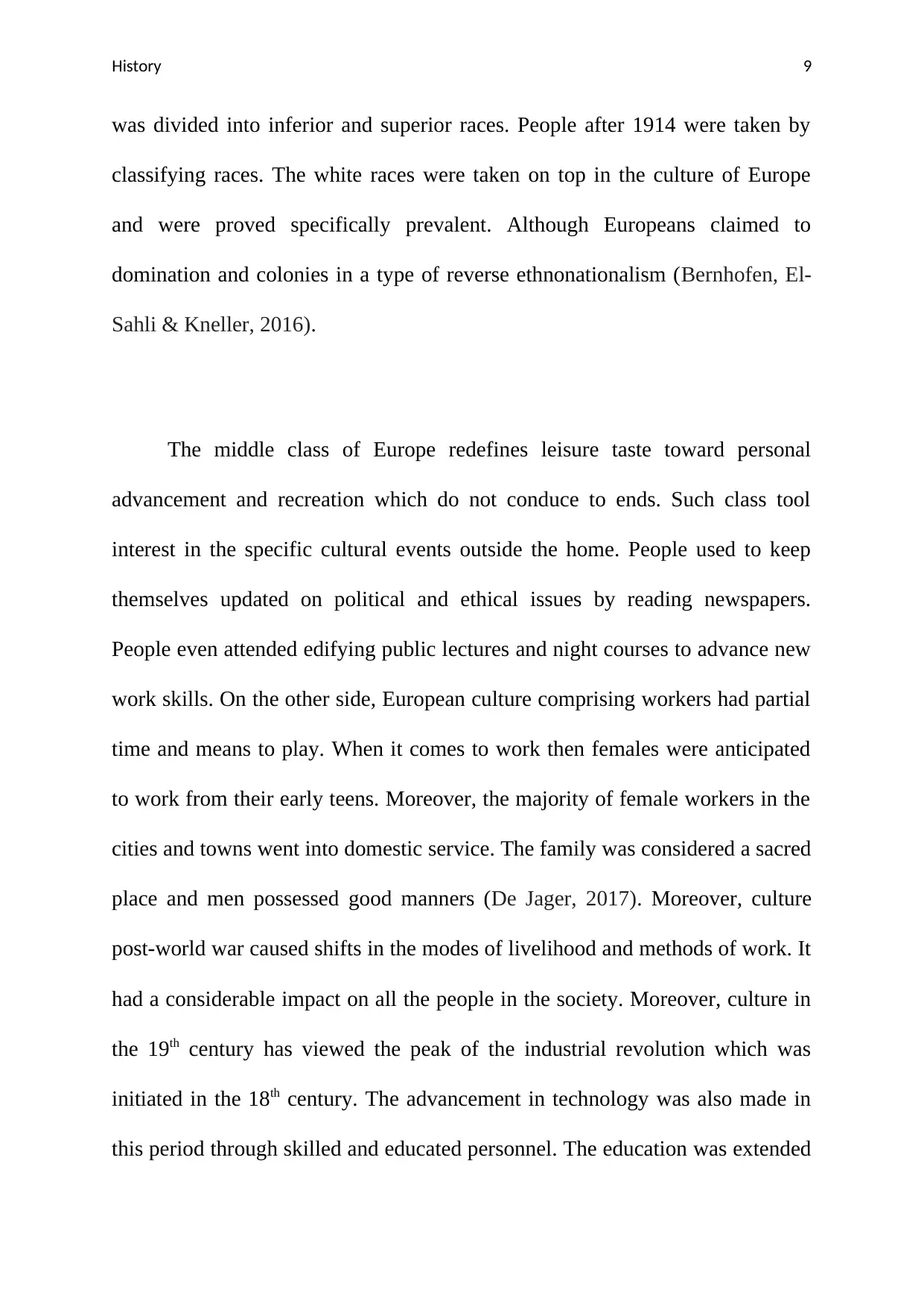
History 9
was divided into inferior and superior races. People after 1914 were taken by
classifying races. The white races were taken on top in the culture of Europe
and were proved specifically prevalent. Although Europeans claimed to
domination and colonies in a type of reverse ethnonationalism (Bernhofen, El-
Sahli & Kneller, 2016).
The middle class of Europe redefines leisure taste toward personal
advancement and recreation which do not conduce to ends. Such class tool
interest in the specific cultural events outside the home. People used to keep
themselves updated on political and ethical issues by reading newspapers.
People even attended edifying public lectures and night courses to advance new
work skills. On the other side, European culture comprising workers had partial
time and means to play. When it comes to work then females were anticipated
to work from their early teens. Moreover, the majority of female workers in the
cities and towns went into domestic service. The family was considered a sacred
place and men possessed good manners (De Jager, 2017). Moreover, culture
post-world war caused shifts in the modes of livelihood and methods of work. It
had a considerable impact on all the people in the society. Moreover, culture in
the 19th century has viewed the peak of the industrial revolution which was
initiated in the 18th century. The advancement in technology was also made in
this period through skilled and educated personnel. The education was extended
was divided into inferior and superior races. People after 1914 were taken by
classifying races. The white races were taken on top in the culture of Europe
and were proved specifically prevalent. Although Europeans claimed to
domination and colonies in a type of reverse ethnonationalism (Bernhofen, El-
Sahli & Kneller, 2016).
The middle class of Europe redefines leisure taste toward personal
advancement and recreation which do not conduce to ends. Such class tool
interest in the specific cultural events outside the home. People used to keep
themselves updated on political and ethical issues by reading newspapers.
People even attended edifying public lectures and night courses to advance new
work skills. On the other side, European culture comprising workers had partial
time and means to play. When it comes to work then females were anticipated
to work from their early teens. Moreover, the majority of female workers in the
cities and towns went into domestic service. The family was considered a sacred
place and men possessed good manners (De Jager, 2017). Moreover, culture
post-world war caused shifts in the modes of livelihood and methods of work. It
had a considerable impact on all the people in the society. Moreover, culture in
the 19th century has viewed the peak of the industrial revolution which was
initiated in the 18th century. The advancement in technology was also made in
this period through skilled and educated personnel. The education was extended
Secure Best Marks with AI Grader
Need help grading? Try our AI Grader for instant feedback on your assignments.
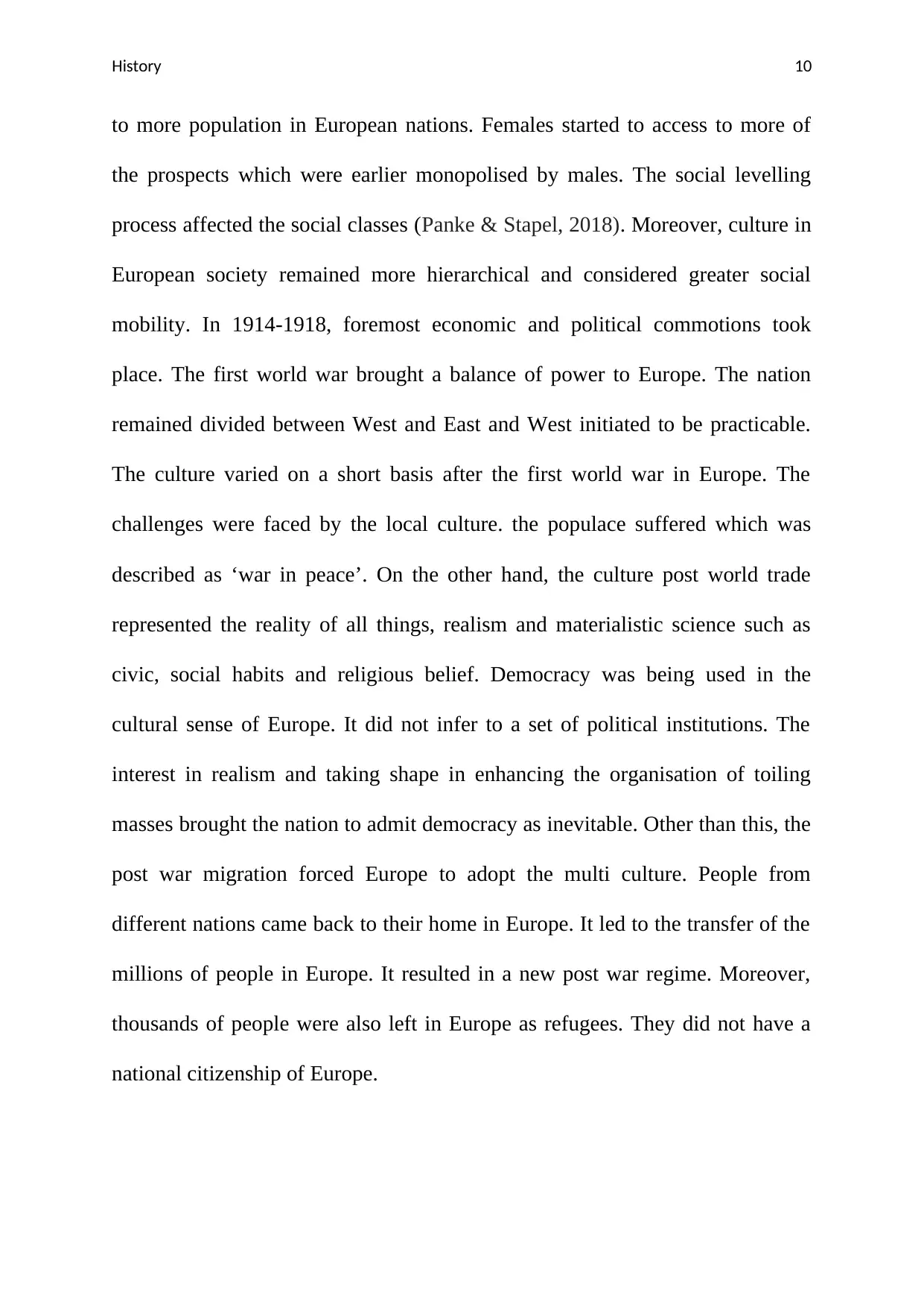
History 10
to more population in European nations. Females started to access to more of
the prospects which were earlier monopolised by males. The social levelling
process affected the social classes (Panke & Stapel, 2018). Moreover, culture in
European society remained more hierarchical and considered greater social
mobility. In 1914-1918, foremost economic and political commotions took
place. The first world war brought a balance of power to Europe. The nation
remained divided between West and East and West initiated to be practicable.
The culture varied on a short basis after the first world war in Europe. The
challenges were faced by the local culture. the populace suffered which was
described as ‘war in peace’. On the other hand, the culture post world trade
represented the reality of all things, realism and materialistic science such as
civic, social habits and religious belief. Democracy was being used in the
cultural sense of Europe. It did not infer to a set of political institutions. The
interest in realism and taking shape in enhancing the organisation of toiling
masses brought the nation to admit democracy as inevitable. Other than this, the
post war migration forced Europe to adopt the multi culture. People from
different nations came back to their home in Europe. It led to the transfer of the
millions of people in Europe. It resulted in a new post war regime. Moreover,
thousands of people were also left in Europe as refugees. They did not have a
national citizenship of Europe.
to more population in European nations. Females started to access to more of
the prospects which were earlier monopolised by males. The social levelling
process affected the social classes (Panke & Stapel, 2018). Moreover, culture in
European society remained more hierarchical and considered greater social
mobility. In 1914-1918, foremost economic and political commotions took
place. The first world war brought a balance of power to Europe. The nation
remained divided between West and East and West initiated to be practicable.
The culture varied on a short basis after the first world war in Europe. The
challenges were faced by the local culture. the populace suffered which was
described as ‘war in peace’. On the other hand, the culture post world trade
represented the reality of all things, realism and materialistic science such as
civic, social habits and religious belief. Democracy was being used in the
cultural sense of Europe. It did not infer to a set of political institutions. The
interest in realism and taking shape in enhancing the organisation of toiling
masses brought the nation to admit democracy as inevitable. Other than this, the
post war migration forced Europe to adopt the multi culture. People from
different nations came back to their home in Europe. It led to the transfer of the
millions of people in Europe. It resulted in a new post war regime. Moreover,
thousands of people were also left in Europe as refugees. They did not have a
national citizenship of Europe.
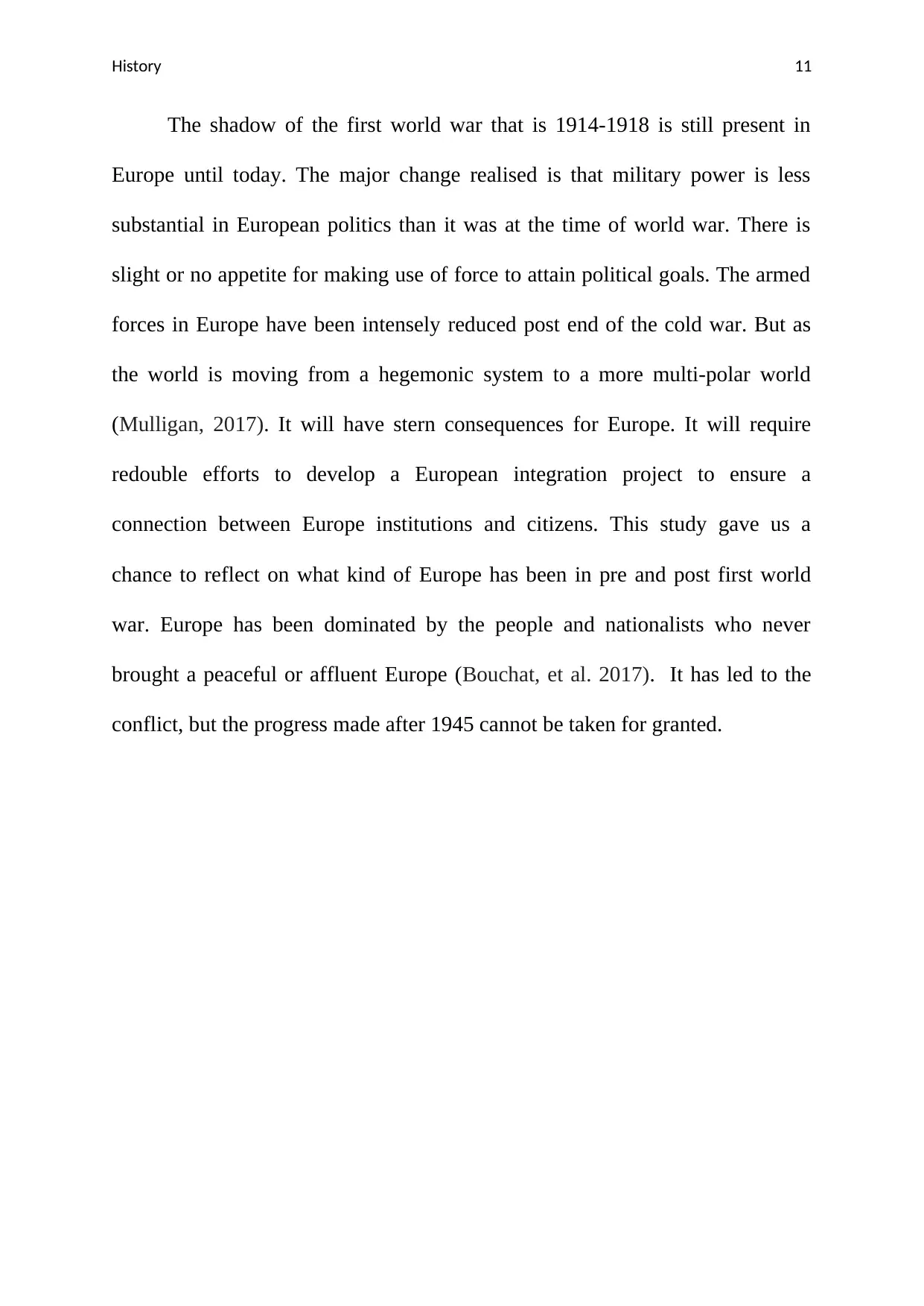
History 11
The shadow of the first world war that is 1914-1918 is still present in
Europe until today. The major change realised is that military power is less
substantial in European politics than it was at the time of world war. There is
slight or no appetite for making use of force to attain political goals. The armed
forces in Europe have been intensely reduced post end of the cold war. But as
the world is moving from a hegemonic system to a more multi-polar world
(Mulligan, 2017). It will have stern consequences for Europe. It will require
redouble efforts to develop a European integration project to ensure a
connection between Europe institutions and citizens. This study gave us a
chance to reflect on what kind of Europe has been in pre and post first world
war. Europe has been dominated by the people and nationalists who never
brought a peaceful or affluent Europe (Bouchat, et al. 2017). It has led to the
conflict, but the progress made after 1945 cannot be taken for granted.
The shadow of the first world war that is 1914-1918 is still present in
Europe until today. The major change realised is that military power is less
substantial in European politics than it was at the time of world war. There is
slight or no appetite for making use of force to attain political goals. The armed
forces in Europe have been intensely reduced post end of the cold war. But as
the world is moving from a hegemonic system to a more multi-polar world
(Mulligan, 2017). It will have stern consequences for Europe. It will require
redouble efforts to develop a European integration project to ensure a
connection between Europe institutions and citizens. This study gave us a
chance to reflect on what kind of Europe has been in pre and post first world
war. Europe has been dominated by the people and nationalists who never
brought a peaceful or affluent Europe (Bouchat, et al. 2017). It has led to the
conflict, but the progress made after 1945 cannot be taken for granted.
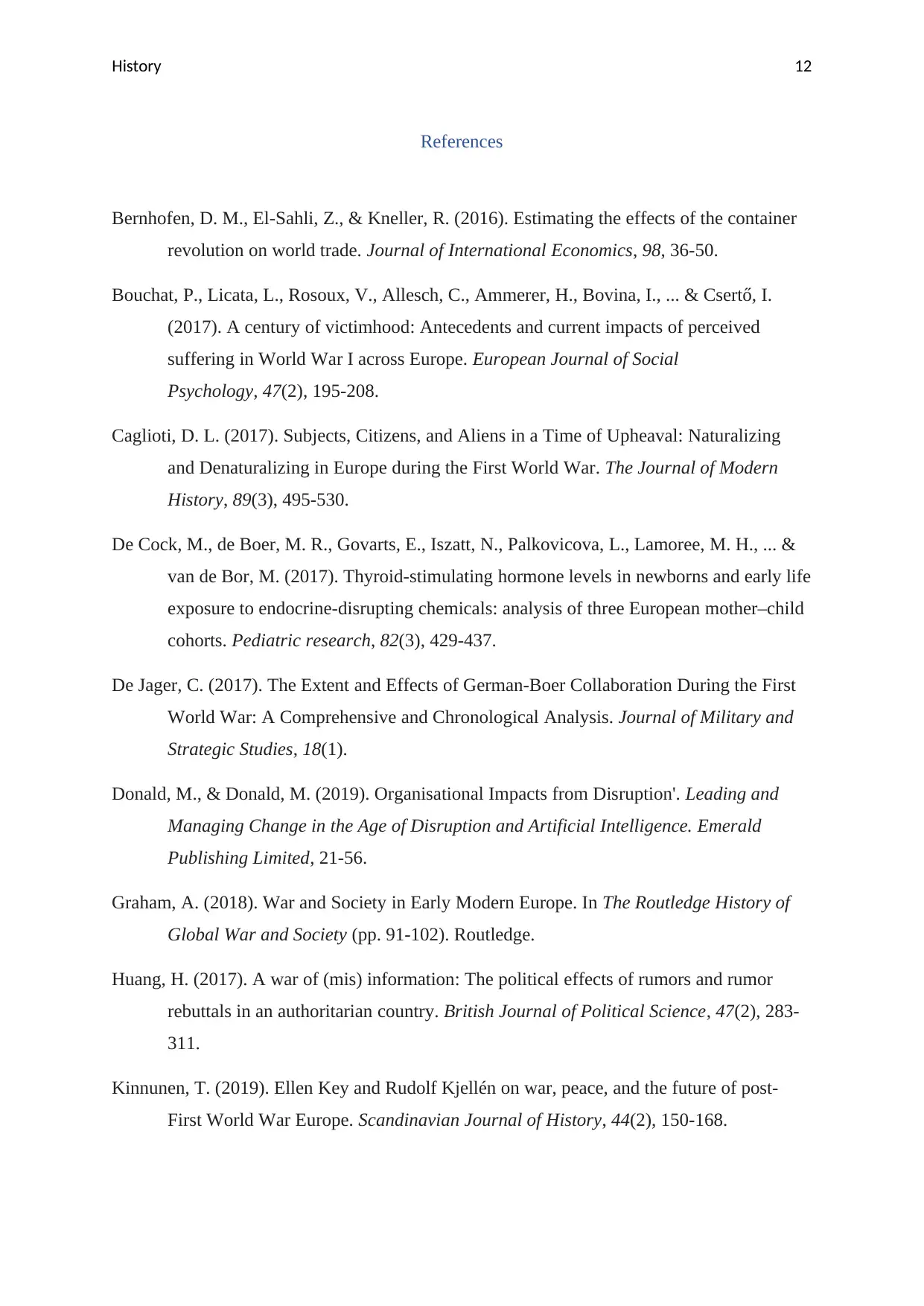
History 12
References
Bernhofen, D. M., El-Sahli, Z., & Kneller, R. (2016). Estimating the effects of the container
revolution on world trade. Journal of International Economics, 98, 36-50.
Bouchat, P., Licata, L., Rosoux, V., Allesch, C., Ammerer, H., Bovina, I., ... & Csertő, I.
(2017). A century of victimhood: Antecedents and current impacts of perceived
suffering in World War I across Europe. European Journal of Social
Psychology, 47(2), 195-208.
Caglioti, D. L. (2017). Subjects, Citizens, and Aliens in a Time of Upheaval: Naturalizing
and Denaturalizing in Europe during the First World War. The Journal of Modern
History, 89(3), 495-530.
De Cock, M., de Boer, M. R., Govarts, E., Iszatt, N., Palkovicova, L., Lamoree, M. H., ... &
van de Bor, M. (2017). Thyroid-stimulating hormone levels in newborns and early life
exposure to endocrine-disrupting chemicals: analysis of three European mother–child
cohorts. Pediatric research, 82(3), 429-437.
De Jager, C. (2017). The Extent and Effects of German-Boer Collaboration During the First
World War: A Comprehensive and Chronological Analysis. Journal of Military and
Strategic Studies, 18(1).
Donald, M., & Donald, M. (2019). Organisational Impacts from Disruption'. Leading and
Managing Change in the Age of Disruption and Artificial Intelligence. Emerald
Publishing Limited, 21-56.
Graham, A. (2018). War and Society in Early Modern Europe. In The Routledge History of
Global War and Society (pp. 91-102). Routledge.
Huang, H. (2017). A war of (mis) information: The political effects of rumors and rumor
rebuttals in an authoritarian country. British Journal of Political Science, 47(2), 283-
311.
Kinnunen, T. (2019). Ellen Key and Rudolf Kjellén on war, peace, and the future of post-
First World War Europe. Scandinavian Journal of History, 44(2), 150-168.
References
Bernhofen, D. M., El-Sahli, Z., & Kneller, R. (2016). Estimating the effects of the container
revolution on world trade. Journal of International Economics, 98, 36-50.
Bouchat, P., Licata, L., Rosoux, V., Allesch, C., Ammerer, H., Bovina, I., ... & Csertő, I.
(2017). A century of victimhood: Antecedents and current impacts of perceived
suffering in World War I across Europe. European Journal of Social
Psychology, 47(2), 195-208.
Caglioti, D. L. (2017). Subjects, Citizens, and Aliens in a Time of Upheaval: Naturalizing
and Denaturalizing in Europe during the First World War. The Journal of Modern
History, 89(3), 495-530.
De Cock, M., de Boer, M. R., Govarts, E., Iszatt, N., Palkovicova, L., Lamoree, M. H., ... &
van de Bor, M. (2017). Thyroid-stimulating hormone levels in newborns and early life
exposure to endocrine-disrupting chemicals: analysis of three European mother–child
cohorts. Pediatric research, 82(3), 429-437.
De Jager, C. (2017). The Extent and Effects of German-Boer Collaboration During the First
World War: A Comprehensive and Chronological Analysis. Journal of Military and
Strategic Studies, 18(1).
Donald, M., & Donald, M. (2019). Organisational Impacts from Disruption'. Leading and
Managing Change in the Age of Disruption and Artificial Intelligence. Emerald
Publishing Limited, 21-56.
Graham, A. (2018). War and Society in Early Modern Europe. In The Routledge History of
Global War and Society (pp. 91-102). Routledge.
Huang, H. (2017). A war of (mis) information: The political effects of rumors and rumor
rebuttals in an authoritarian country. British Journal of Political Science, 47(2), 283-
311.
Kinnunen, T. (2019). Ellen Key and Rudolf Kjellén on war, peace, and the future of post-
First World War Europe. Scandinavian Journal of History, 44(2), 150-168.
Paraphrase This Document
Need a fresh take? Get an instant paraphrase of this document with our AI Paraphraser
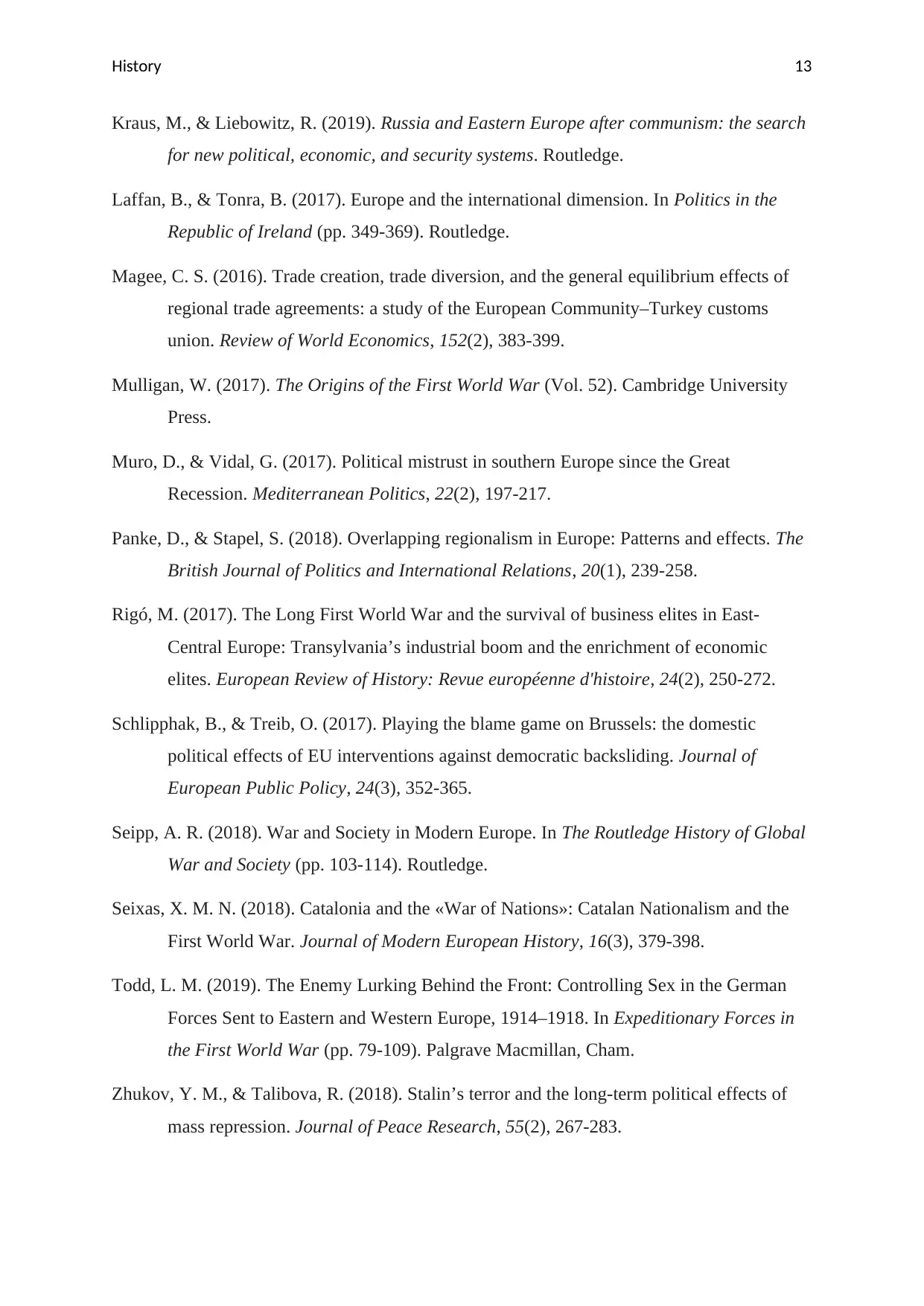
History 13
Kraus, M., & Liebowitz, R. (2019). Russia and Eastern Europe after communism: the search
for new political, economic, and security systems. Routledge.
Laffan, B., & Tonra, B. (2017). Europe and the international dimension. In Politics in the
Republic of Ireland (pp. 349-369). Routledge.
Magee, C. S. (2016). Trade creation, trade diversion, and the general equilibrium effects of
regional trade agreements: a study of the European Community–Turkey customs
union. Review of World Economics, 152(2), 383-399.
Mulligan, W. (2017). The Origins of the First World War (Vol. 52). Cambridge University
Press.
Muro, D., & Vidal, G. (2017). Political mistrust in southern Europe since the Great
Recession. Mediterranean Politics, 22(2), 197-217.
Panke, D., & Stapel, S. (2018). Overlapping regionalism in Europe: Patterns and effects. The
British Journal of Politics and International Relations, 20(1), 239-258.
Rigó, M. (2017). The Long First World War and the survival of business elites in East-
Central Europe: Transylvania’s industrial boom and the enrichment of economic
elites. European Review of History: Revue européenne d'histoire, 24(2), 250-272.
Schlipphak, B., & Treib, O. (2017). Playing the blame game on Brussels: the domestic
political effects of EU interventions against democratic backsliding. Journal of
European Public Policy, 24(3), 352-365.
Seipp, A. R. (2018). War and Society in Modern Europe. In The Routledge History of Global
War and Society (pp. 103-114). Routledge.
Seixas, X. M. N. (2018). Catalonia and the «War of Nations»: Catalan Nationalism and the
First World War. Journal of Modern European History, 16(3), 379-398.
Todd, L. M. (2019). The Enemy Lurking Behind the Front: Controlling Sex in the German
Forces Sent to Eastern and Western Europe, 1914–1918. In Expeditionary Forces in
the First World War (pp. 79-109). Palgrave Macmillan, Cham.
Zhukov, Y. M., & Talibova, R. (2018). Stalin’s terror and the long-term political effects of
mass repression. Journal of Peace Research, 55(2), 267-283.
Kraus, M., & Liebowitz, R. (2019). Russia and Eastern Europe after communism: the search
for new political, economic, and security systems. Routledge.
Laffan, B., & Tonra, B. (2017). Europe and the international dimension. In Politics in the
Republic of Ireland (pp. 349-369). Routledge.
Magee, C. S. (2016). Trade creation, trade diversion, and the general equilibrium effects of
regional trade agreements: a study of the European Community–Turkey customs
union. Review of World Economics, 152(2), 383-399.
Mulligan, W. (2017). The Origins of the First World War (Vol. 52). Cambridge University
Press.
Muro, D., & Vidal, G. (2017). Political mistrust in southern Europe since the Great
Recession. Mediterranean Politics, 22(2), 197-217.
Panke, D., & Stapel, S. (2018). Overlapping regionalism in Europe: Patterns and effects. The
British Journal of Politics and International Relations, 20(1), 239-258.
Rigó, M. (2017). The Long First World War and the survival of business elites in East-
Central Europe: Transylvania’s industrial boom and the enrichment of economic
elites. European Review of History: Revue européenne d'histoire, 24(2), 250-272.
Schlipphak, B., & Treib, O. (2017). Playing the blame game on Brussels: the domestic
political effects of EU interventions against democratic backsliding. Journal of
European Public Policy, 24(3), 352-365.
Seipp, A. R. (2018). War and Society in Modern Europe. In The Routledge History of Global
War and Society (pp. 103-114). Routledge.
Seixas, X. M. N. (2018). Catalonia and the «War of Nations»: Catalan Nationalism and the
First World War. Journal of Modern European History, 16(3), 379-398.
Todd, L. M. (2019). The Enemy Lurking Behind the Front: Controlling Sex in the German
Forces Sent to Eastern and Western Europe, 1914–1918. In Expeditionary Forces in
the First World War (pp. 79-109). Palgrave Macmillan, Cham.
Zhukov, Y. M., & Talibova, R. (2018). Stalin’s terror and the long-term political effects of
mass repression. Journal of Peace Research, 55(2), 267-283.
1 out of 14
Related Documents
Your All-in-One AI-Powered Toolkit for Academic Success.
+13062052269
info@desklib.com
Available 24*7 on WhatsApp / Email
![[object Object]](/_next/static/media/star-bottom.7253800d.svg)
Unlock your academic potential
© 2024 | Zucol Services PVT LTD | All rights reserved.





